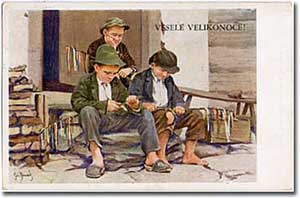Remember playing ring toss at the county fair? Bring that fun
home with this homemade version of your carnival favorite. Cut out the
centers of paper plates, paint them, and you've got rings ready to be
tossed! This game is a fun way to teach young kids about direction and
number values, or teach older kids about addition! It's a great creative
project to do any day you're yearning for the fair, and it stops
boredom in its tracks!

What You Need:
- Paper plates (4-8)
- Black marker
- Scissors
- 3 bottles (glass or plastic)
- Sand, or water
- Tempera paint
- Paintbrushes
What You Do:
- Cover the surface of your workspace with newspaper to protect your furniture from paint.
- Have your child cut out the center of each paper plate. The border that remains will be the paper rings.
- Using the tempera paint, have him paint each ring a different color. Encourage him to paint different designs and patterns on each ring. Allow the paint to dry completely.
- Help him to fill the bottles with water or sand to help weigh them down so they don't tip during the game.
- Have him use the black marker to write ascending numbers on each plate to create a point system, such as: 1,2,3 or 10, 50, 100.
- Place the bottles on the floor, allowing enough room between each bottle which will allow the rings to land over the bottle without interference.
- Give each of the players the same number of paper rings.
- Have the players stand a few feet away from the bottles and toss the rings.
- Add up the number of points for each ring that is successfully tossed over the bottle. Whoever ends up with the most points after all the rings are tossed is the winner!





